Sotho people
The Sotho /ˈsuːtuː/[2] people, or Basotho /bæˈsuːtuː/, are a Bantu ethnic group of Southern Africa who speak Sesotho. They are native to modern Lesotho and South Africa. The Basotho have inhabited the region since around the fifth century CE and are closely related to other Bantu peoples of the region.
 King Moshoeshoe I, founder of the Basotho nation, with his Ministers. | |
| Total population | |
|---|---|
| c. 6 million (2001 est.) | |
| Regions with significant populations | |
| 3,544,304 (2001 census) to 4,723,000[1] | |
| 1,669,000[1] | |
| 11,000[1] | |
| 6,000[1] | |
| 3,000 | |
| 2,000 | |
| 1,500 | |
| 1,000 | |
| 500 | |
| 300 | |
| 100 | |
| Languages | |
| Sesotho, English | |
| Religion | |
| African traditional religion, Christianity | |
| Related ethnic groups | |
| Northern Sotho, Tswana, Lozi | |
| Sotho | |
|---|---|
| Person | Mosotho |
| People | Basotho |
| Language | Sesotho |
| Country | Lesotho |
The modern Basotho identity emerged from the accomplished diplomacy of Moshoeshoe I who unified the disparate clans of Sotho–Tswana origin that had dispersed across southern Africa in the early 19th century. Most Basotho today live in Lesotho or South Africa, as the area of the Orange Free State was originally part of Moshoeshoe's nation (now Lesotho).
History
Early history
Bantu-speaking peoples had settled in what is now South Africa by about 500 CE.[3][4] Separation from the Tswana is assumed to have taken place by the 14th century. The first historical references to the Basotho date to the 19th century. By that time, a series of Basotho kingdoms covered the southern portion of the plateau (Free State Province and parts of Gauteng). Basotho society was highly decentralized, and organized on the basis of kraals, or extended clans, each of which was ruled by a chief.[5] Fiefdoms were united into loose confederations.[5]
19th century
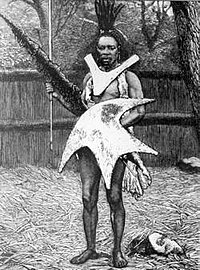
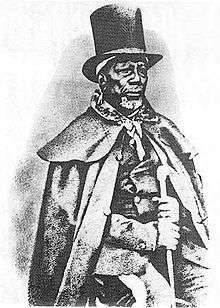
In the 1820s, refugees from the Zulu expansion under Shaka[6] came into contact with the Basotho people residing on the highveld. In 1823, pressure caused one group of Basotho, the Kololo, to migrate north. They moved past the Okavango Swamp and across the Zambezi into Barotseland, which is now part of Zambia.[7] In 1845, the Kololo conquered Barotseland.[8]
At about the same time, the Boers began to encroach upon Basotho territory.[9] After the Cape Colony was ceded to Britain at the conclusion of the Napoleonic Wars, farmers who opted to leave the former Dutch colony were called the voortrekkers ("pioneers") and moved inland where they eventually established independent polities.[9][10]
At the time of these developments, Moshoeshoe I gained control of the Basotho kingdoms of the southern highveld.[10] Universally praised as a skilled diplomat and strategist, he moulded the disparate refugee groups escaping the Difaqane into a cohesive nation.[11] His leadership allowed his small nation to survive the obstacles that destroyed other indigenous South African kingdoms during the 19th century, such as the Zulu hegemony, the inward expansion of the voortrekkers and the plans of imperial Britain.[12]
In 1822, Moshoeshoe established the capital at Butha-Buthe, an easily defensible mountain in the northern Drakensberg mountain range, thus laying the foundations of the eventual Kingdom of Lesotho.[11] His capital was later moved to Thaba Bosiu.[11]
To deal with the encroaching voortrekker groups, Moshoeshoe encouraged French missionary activity in his kingdom.[13] Missionaries sent by the Paris Evangelical Missionary Society provided the King with foreign affairs counsel and helped to facilitate the purchase of modern weapons.[13]
Aside from acting as state ministers, missionaries (primarily Casalis and Arbousset) played a vital role in delineating Sesotho orthography and printing Sesotho language materials between 1837 and 1855.[14] The first Sesotho translation of the Bible appeared in 1878.[15]
In 1868, after losing the western lowlands to the Boers during the Free State–Basotho Wars, Moshoeshoe successfully appealed to Queen Victoria to proclaim Basutoland (modern Lesotho) a protectorate of Britain. Accordingly, the British administration was established in Maseru, the site of Lesotho's current capital.[9] Local chieftains retained power over internal affairs, while Britain was responsible for foreign affairs and the defense of the protectorate.[16]
In 1869, the British sponsored a process to demarcate the borders of Basutoland.[9] While many clans had territory within Basutoland, large numbers of Sesotho speakers resided in areas allocated to the Orange Free State, the sovereign voortrekker republic that bordered the Basotho kingdom.
Cannibalism
The practice of cannibalism increased among the Basotho during the times of lifaqane (literally "need for sustenance" or "we want") when there were many refugee tribes fleeing wars started by the Zulu King Shaka. According to missionary Ellenberger, tribes who practiced cannibalism were the Bakhatla of Tabane, specifically those who were ruled by the Chief Rakotsoane at Sefikeng.
The district of Mangane, now known as Bloemfontein, was described as ‘infested with cannibals’ by the end of 1822. A cave at Mohale’s Hoek had a brotherhood of 27 cannibals who were under the leadership of Motleyoa. Other areas known to have cannibals included the river banks of Cornelius Spruit, where there were several villages of cannibals.
According to the Basotho, cannibals are regarded as people having evil supernatural powers comparable with Satan or spirits of the dead that oppose the good spirits and Basotho ancestors. Their tradition states that the great Bakuena chief, Mohlomi, prophesied the coming of the lifaqane and cannibalism on his death bed with the words, "After my death, a cloud of red dust will come out of the east and consume our tribes. The father will eat his children. I greet you all, and depart to where our fathers rest."[17][18]
The Basotho cannibals believed that their human victims would appease the gods. Missionaries who arrived in 1883 estimated that there were between 7,000 and 8,000 Basotho practicing cannibalism between the Orange River, the Drakensberg and the Vaal river.
Moeshoeshoe and his people experienced an attack by cannibals as they moved from Butha Buthe to Thaba Bosiu seeking safety from King Shaka’s wars in 1824. During the attack, the cannibals captured and ate Moshoeshoe’s grandfather, Peete. Although cannibals were the cause of his grandfather's death, Moeshoeshoe chose not to punish captured cannibals. Instead, he decided to aid them in their rehabilitation into society by giving them food and cattle.[19]
From 1822 to 1828, there were about 300,000 victims of cannibalism. The practice stopped shortly after the arrival of Christian missionaries as cannibalism was not tolerated in the Christian lifestyle.[20] The Cannibal Trail just outside Clarens in the eastern Free State runs between the Rooiberge and Witteberg mountains, where cannibals used to reside.[21]
20th century
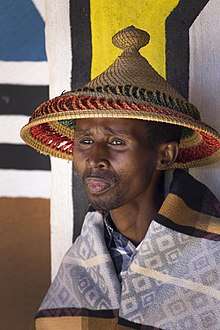
Britain's protection ensured that repeated attempts by the Orange Free State, and later the Republic of South Africa, to absorb part or all of Basutoland were unsuccessful.[4] In 1966, Basutoland gained its independence from Britain, becoming the Kingdom of Lesotho.
Sesotho is widely spoken throughout the sub-continent due to internal migration. To enter the cash economy, Basotho men often migrated to large cities in South Africa to find employment in the mining industry.[22] Migrant workers from the Free State and Lesotho thus helped to spread Sesotho to the urban areas of South Africa. It is generally agreed that migrant work harmed the family life of most Sesotho speakers because adults (primarily men) were required to leave their families behind in impoverished communities while they were employed in distant cities.[22]
Attempts by the apartheid government to force Sesotho speakers to relocate to designated homelands had little effect on their settlement patterns. Large numbers of workers continued to leave the traditional areas of Black settlement.[4] Women gravitated towards employment as agricultural or domestic workers while men typically found employment in the mining sector.[4]
In terms of religion, the central role that Christian missionaries played in helping Moshoeshoe I secure his kingdom helped to ensure widespread Basotho conversion to Christianity. Today, the bulk of Sesotho speakers practice a form of Christianity that blends elements of traditional Christian dogma with local, pre-Western beliefs. Modimo (“God”) is viewed as a supreme being who cannot be approached by mortals. Ancestors are seen as intercessors between Modimo and the living, and their favor must be cultivated through worship and reverence.[23] Officially, the majority of Lesotho's population is Catholic.[24]
The Basotho's heartland is the Free State province in South Africa and neighboring Lesotho.[25] Both of these largely rural areas have widespread poverty and underdevelopment.[26] Many Sesotho speakers live in conditions of economic hardship, but people with access to land and steady employment may enjoy a higher standard of living.[26] Landowners often participate in subsistence or small-scale commercial farming ventures.[24] However, overgrazing and land mismanagement are growing problems.[24]
Demographics
The allure of urban areas has not diminished, and internal migration continues today for many black people born in Lesotho and other Basotho heartlands.[27] Generally, employment patterns among the Basotho follow the same patterns as broader South African society. Historical factors cause unemployment among the Basotho and other Black South Africans to remain high.[26]
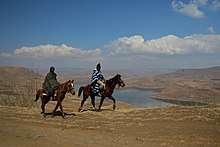
Percent of Sesotho speakers across South Africa:[28]
- Gauteng Province: 13.1%
- Atteridgeville: 12.3%
- City of Johannesburg Metropolitan Municipality: 9.6%
- Soweto: 15.5%
- Ekurhuleni Metropolitan Municipality: 10.02%
- Katlehong: 22.4%
- Sedibeng District Municipality: 46.7%
- West Rand District Municipality: 10.8%
- Midvaal Local Municipality: 27.9%
- Free State Province: 64.2%
- Bloemfontein: 33.4%
Language
The language of the Basotho is referred to as Sesotho,[29] less commonly known as Sesotho sa borwa.[30] Some texts may refer to Sesotho as "Southern Sotho" to differentiate it from Northern Sotho, also called Sepedi.
Sesotho is the first language of 1.5 million people in Lesotho, or 85% of the population.[24] It is one of the two official languages in Lesotho, the other being English.[24] Lesotho enjoys one of Africa's highest literacy rates, with 59% of the adult population being literate, chiefly in Sesotho.[31]
Sesotho is one of the eleven official languages of South Africa.[29] According to the South African National Census of 2011, almost 4 million people speak Sesotho as a first language, including 62% of Free State inhabitants.[32] Approximately 13.1% of the residents of Gauteng speak Sesotho as a first language.[28] In the North West Province, 5% of the population speak Sesotho as a first language, with a concentration of speakers in the Maboloka region.[32] Three percent of Mpumalanga's people speak Sesotho as a first language, with many speakers living in the Standerton area.[32] Two percent of the residents of the Eastern Cape speak Sesotho as a first language, though they are located mostly in the northern part of the province.[32]
Aside from Lesotho and South Africa, 60,000 people speak Silozi (a close relative of Sesotho) in Zambia.[33] Additionally, a few Sesotho speakers reside in Botswana, Swaziland and the Caprivi Strip of Namibia.[33] No official statistics on second language usage are available, but one conservative estimate of the number of people who speak Sesotho as a second (or later) language is 5 million.[33]
Sesotho is used in a range of educational settings both as a subject of study and as a medium of instruction.[31] It is used in its spoken and written forms in all spheres of education, from preschool to doctoral studies.[31] However, the number of technical materials (e.g. in the fields of commerce, information technology, law, science, and math) in the language is still relatively small.[31]
Sesotho has developed a sizable media presence since the end of apartheid. Lesedi FM is a 24-hour Sesotho radio station run by the South African Broadcasting Corporation (SABC), broadcasting solely in Sesotho. There are other regional radio stations throughout Lesotho and the Free State.[31] Half-hour Sesotho news bulletins are broadcast daily on the SABC free-to-air channel SABC 2. Independent TV broadcaster eTV also features a daily half-hour Sesotho bulletin. Both SABC and the eTV group produce a range of programs that feature some Sesotho dialogue.
In Lesotho, the Lesotho National Broadcasting Service broadcasts to South Africa via satellite pay-TV provider, DStv.
Most newspapers in Lesotho are written in Sesotho or both Sesotho and English. There are no fully fledged newspapers in Sesotho except for regional newsletters in Qwaqwa, Fouriesburg, Ficksburg and possibly other Free State towns.[31]
Currently, the mainstream South African magazine Bona includes Sesotho content.[31] Since the codification of Sesotho orthography, literary works have been produced in Sesotho. Notable Sesotho-language literature includes Thomas Mofolo's epic Chaka, which has been translated into several languages including English and German.[34]
Clothing
The Basotho have a unique traditional attire. This includes the mokorotlo, a conical hat with a decorated knob at the top that is worn differently for men and women. The Basotho blanket is often worn over the shoulders or the waist and protects the wearer against the cold. Although many Sotho people wear westernized clothing, often traditional garments are worn over them.
Basotho herders
Many Basotho who live in rural areas wear clothing that suits their lifestyles. For instance, boys who herd cattle in the rural Free State and Lesotho wear the Basotho blanket and large rain boots (gumboots) as protection from the wet mountain terrain. Herd boys also often wear woolen balaclavas or caps year-round to protect their faces from cold temperatures and dusty winds.
Basotho women
Basotho women usually wear skirts and long dresses in bright colors and patterns, as well as the traditional blankets around the waist. On special occasions like wedding celebrations, they wear the Seshoeshoe, a traditional Basotho dress. The local traditional dresses are made using colored cloth and ribbon accents bordering each layer. Sotho women often purchase this material and have it designed in a style similar to West and East African dresses.
Women often wrap a long print cloth or a small blanket around their waist, either as a skirt or a second garment over it. This is commonly known as a wrap, and it can be used to carry infants on their backs.[35]
Special clothing items
Special clothing is worn for special events like initiation rites and traditional healing ceremonies.
For a Lebollo la basadi, or a girl's initiation ceremony, girls wear a beaded waist wrap called a thethana that covers the waist, particularly the crotch area and part of the buttocks. They also wear grey blankets and goatskin skirts. These garments are worn by young girls and women, particularly virgins.
For a Lebollo la banna, or a boy's initiation ceremony, boys wear a loincloth called a tshea as well as colorful blankets. These traditional outfits are often combined with more modern items like sunglasses.
Traditional Sotho healers wear the bandolier which consists of strips and strings made of leather, sinew or beads that form a cross on the chest. The bandolier often has pouches of potions attached to it for specific rituals or physical/spiritual protection. It is believed that the San people adopted this bandolier attire for healers during times when the Basotho and the San traded and developed ties through trade, marriage and friendship. The San people's use of the bandolier can be seen in their rock paintings that date to the 1700s.[36][37]
- Sotho Cultural Clothing
 Brown shweshwe.
Brown shweshwe.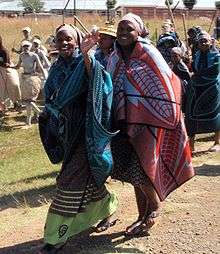 Seana Marena woollen tribal blanket traditionally
Seana Marena woollen tribal blanket traditionally Mokorotlo is a type of straw hat
Mokorotlo is a type of straw hat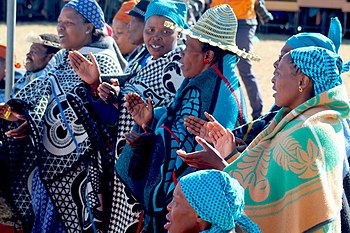 Basotho Women durig Mokhibo
Basotho Women durig Mokhibo
Notable Sotho people
Politics
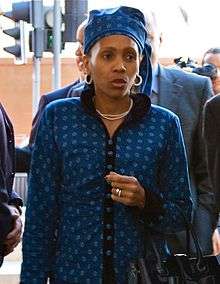
- Moshoeshoe I - Founder of the Basotho nation
- Moshoeshoe II - Paramount Chief of Lesotho
- King Letsie - Reigning King of the Basotho
- Queen 'Masenate Mohato Seeiso - the queen consort of Lesotho
- Pakalitha Mosisili - Former Prime Minister of Lesotho
- Ace Magashule - Secretary General of the African National Congress, Former Premier of the Free State
- Tom Thabane - Former Prime Minister of Lesotho
- Ntsu Mokhehle - Former Prime Minister of Lesotho
- Leabua Jonathan - Former Prime Minister of Lesotho
- Mosiuoa Lekota - South African anti-apartheid activist, Member of Parliament. And the current President of the COPE
- Hlaudi Motsoeneng - South African radio personality and broadcasting executive
Entertainment
- Joshua Pulumo Mohapeloa - Music composer
- Lira - South African singer
- Maleh - Lesotho-born singer
- Mpho Koaho - Canadian-born actor of Sotho ancestry
- Terry Pheto - South African actress
- Sankomota - Lesotho Jazz band
- Fana Mokoena - South African actor and Member of Parliament for Economic Freedom Fighters
- Tshepo "Howza" Mosese - South African actor and musician
- Kabelo Mabalane - South African musician and 1/3 of Kwaito group Tkzee
Sports
- Khotso Mokoena - Athlete (Long jump)
- Steve Lekoelea - Former football player for Orlando Pirates
- Aaron Mokoena - Former football player for Jomo Cosmos, Blackburn Rovers, and Portsmouth FC
- Thabo Mooki - Former football player for Kaizer Chiefs and Bafana Bafana
- Abia Nale - Former football player for Kaizer Chiefs
- Lebohang Mokoena - Football player for Moroka Swallows
- Jacob Lekgetho
- Lehlohonolo Seema - Retired footballer, Coach of Chippa United
- Lebohang Maboe - Football player for Mamelodi Sundowns
See also
- Sotho–Tswana peoples
- Sotho-Tswana languages
- Liphofung Historical Site
- Sekhukhuneland
- Sotho calendar
- Battle of Berea
| Wikimedia Commons has media related to Sotho people. |
References
- "The Basotho people group are reported in 5 countries". Retrieved 26 December 2014.
- "Sotho". Oxford English Dictionary (3rd ed.). Oxford University Press. September 2005. (Subscription or UK public library membership required.)
- L. Thompson, A History of South Africa (2001); James L. Newman, The Peopling of Africa: A Geographic Interpretation, Yale University Press, New Haven, 1995.
- Bundy, C.; C. Saunders (1989). Illustrated History of South Africa: The Real Story. Cape Town: Readers Digest.
- Laband, J. (2003). "Mfecane". Encarta Encyclopedia. Redmond: Microsoft Corporation.
- Ross, R. (2009). A Concise History of South Africa. Cambridge: Cambridge University Press.
- Muimui, Lubosi. "Political History of Barotseland". Archived from the original on 23 April 2014.
- Phiri, Bizeck J. (2005). "Lozi Kingdom and the Kololo". In Shillington, Kevin (ed.). Encyclopedia of African History, Volume II, H-O. New York: Fitzroy Dearborn (Routledge). pp. 851–852. ISBN 978-1-57958-454-2.
- Ross, R. (2009). A Concise History of South Africa. Cambridge: Cambridge University Press..
- Thompson, L. (2001). A History of South Africa. Cambridge: Yale University Press..
- Becker, P. (1969). Hill of destiny: the life and times of Moshesh, founder of the Basuto. London: Longman.
- __ (2003). "Moshoeshoe". Encarta Encyclopedia. Redmond: Microsoft Corporation.CS1 maint: numeric names: authors list (link)
- Sanders, P. (1975). Moshoeshoe, chief of the Basotho. London: Heinemann..
- Casalis, E. (1992). The Basutos: or, twenty-three years in South Africa. Morija: Morija Museum & Archives.
- Legassick, M. (1972). The Griqua, The Sotho–Tswana, and the Missionaries, 1780–1840. Ann Arbor: Univ. Microfilms International.
- Grant, N. (1981). Moshoeshoe: Founder of a Nation. London: Longman..
-
- David B. Coplan. In the Time of Cannibals: The Word Music of South Africa's Basotho Migrants. University of Chicago Press, 1994
- Ellenberger, History of the Basuto p 97
- M Prozesky (2016) Ethical leadership resources in southern Africa’s Sesotho speaking culture and in King Moshoeshoe I, Journal of Global Ethics, 12:1, 5-16, DOI: 10.1080/17449626.2016.1146789
- Tsiu, William MorutiBasotho Oral Poetry At the Beginning of the Twenty-first Century. Kwara State University Press, 28 Mar 2018 Page 40-42
- https://showme.co.za/tourism/the-cannibal-hiking-trail-clarens/ Accessed 4 November 2018
- Calinicos, L. (1982), Gold and Workers: 1886–1924, Johannesburg: Ravan Press.
- Bereng, P (1987), I am a Mosotho, Roma, Lesotho: National University of Lesotho.
- Central Intelligence Agency (n.d.) CIA-The World Factbook: Lesotho. Central Intelligence Agency. Retrieved 5-01-10 from https://www.cia.gov/library/publications/the-world-factbook/geos/lt.html
- Mokoena, A. (1998) Sesotho Made Easy. JL van Schaik: Pretoria.
- Davids, Y. (2006) Human Sciences Research Council Review 4 (4). Human Sciences Research Council. Retrieved 5-01-10 from "Archived copy". Archived from the original on 14 July 2010. Retrieved 1 July 2010.CS1 maint: archived copy as title (link)
- Posel, D. (2003) Have Migration Patterns in Post-Apartheid South Africa Changed? Conference on African Migration in Comparative Perspective. Johannesburg: 2003.
- South African National Census of 2011
- Constitution of South Africa (1996)
- Zerbian, S., and Barnard, E. (2008) Phonetics of Intonation in South African Bantu Languages. Southern African Linguistics and Applied Language Studies 26 (2): 235–50.
- United Nations Scientific and Educational Council (UNESCO)(2000) World Languages Survey. Paris: UNESCO.
- STATISTICS SA (2001) Census 2001. Pretoria: Statistics South Africa.
- Lewis, P. (2009) Ethnologue: Languages of the World. Dallas: SIL International.
- Kunene, D. (1989) Thomas Mofolo and the emergence of written Sesotho prose. Johannesburg: Ravan Press, 1989.
- https://www.helplesotho.org/traditional-basotho-dress/
- Dean Foster. The Global Etiquette Guide to Africa and the Middle East: Everything You Need to Know for Business and Travel Success. John Wiley & Sons, 15 Oct 2002, page 259.
- Toyin Falola Ph.D., Daniel Jean-Jacques Africa: An Encyclopedia of Culture and Society [3 volumes]: An Encyclopedia of Culture and Society [3 volumes]: An Encyclopedia of Culture and Society.ABC-CLIO, 14 Dec 2015. Pages 656-657